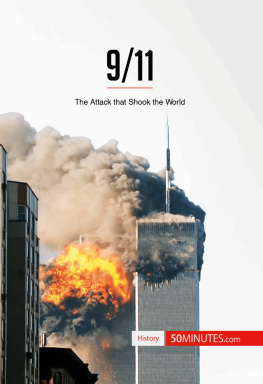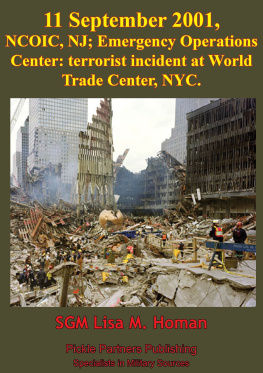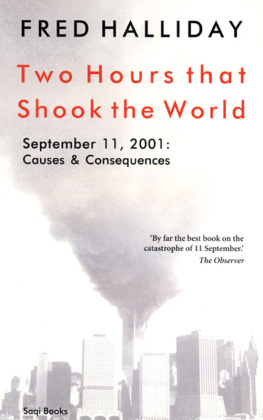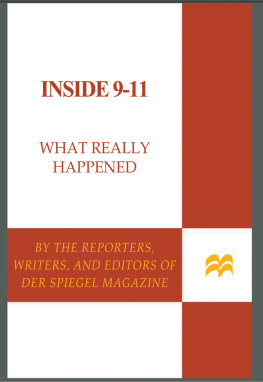
On September 11, 2001, terrorists hijacked four U.S. airplanes: two destroyed the towers of the World Trade Center in New York City, one damaged the Pentagon, and one crashed in a field in Pennsylvania. Author Mara Miller traces the events of that day, gives the historical background, and outlines the steps taken in response so that readers will gain understanding of the horrific attacks and their consequences.
About the Author
Mara Miller has a BA in psychology and an MFA in writing for children. Among her previous books for Enslow Publishers, Inc., is School Desegregation and the Story of the Little Rock Nine.

Contents

Image Credit: Associated Press
It was 8:14 in the morning of September 11, 2001. Skies in the eastern states were clear and blue. The day was bright. Visibility was perfect. Weather conditions for flying did not get much better.
Air traffic controller Pete Zalewski told American Airlines Flight 11 to climb and maintain flight level three-five-zero, 35,000 feet. Zalewski worked at Boston Air Traffic Control Center. He and the other air traffic controllers were responsible for the planes going in and out of Logan International Airport. They made sure the planes had plenty of space and avoided collision.
There was no reply from Flight 11, and the plane stayed at the altitude of 29,000 feet. Zalewski wondered why the pilots were not responding, but he was not too concerned. Perhaps the pilots were not paying attention or there was a problem with the radios frequency.
Are you listening? he asked. The pilots did not answer. Then the plane veered northwest, and the transponder shut off.
A planes transponder tracks the flights number, position, speed, and altitude for the air traffic controllers. Without it, a plane becomes a blip on the radar screen that only shows the speed. Zalewski thought something might be seriously wrong. But he was not thinking hijacking. The plane turned south.
Then, Zalewski heard a foreign voice through the transmitter. We have some planes, it said.
Zalewski yelled to his supervisor, Get over here immediatelyright now! They played back the recorded transmissions as they tried to figure out what was happening with the plane.
Boston Center managers alerted their superiors of the hijacking. They also contacted the military through the Cape Cod facility of the Federal Aviation Administration (FAA). The FAA reached the Northeast Air Defense Sector (NEADS) at 8:37 A.M.
We have a problem here. We have a hijacked aircraft headed towards New York, and we need you guys to, we need someone to scramble some F-16s or something up there, help us out.
Is this real-world or exercise? the person at NEADS asked.
No, this is not an exercisenot a test, the FAA confirmed.
Flight 11 entered controller John Hartlings airspace. Another plane was nearby. He asked the pilots of United Flight 175 if they could see the American Airlines jet. The pilots said that Flight 11 was still at about 28,00029,000 feet. Hartling then asked United 175 to turn 30 degrees to the right. He wanted to keep them out of Flight 11s path. What Hartling did not know was that United 175 also had terrorists on board and would be the next plane in trouble.
Hartling watched Flight 11s speed slow rapidly. Without the transponder, it was the only indication he had that the plane was descending. The plane descended below where the radar could track it. The blip disappeared from the screen.
Seconds after, another air traffic controller, Dave Bottiglia, realized that United Flight 175s transponder signal was also gone.
In the Plane
Flight attendants on board Flight 11 called the airline to let them know that they were in trouble. At about 8:20 A.M. , Betty Ong reached the American Airlines reservation desk. She told a reservationist that the cockpits not answering. Somebodys stabbed in business class and I think theres mace that we cant breathe. I dont know, I think were getting hijacked. She also reported that the purser and galley flight attendant had been stabbed. She said that the plane was flying erratically.
Another flight attendant, Madeline Amy Sweeney, was sitting next to Ong in the back of the plane. The two women were determined to give as much information as they could to the people on the ground. Sweeney called the American Airlines Flight Services Office and was connected to Michael Woodward. She reported the stabbings of the flight attendants in first class and also of a passenger. She gave the seat numbers of some of the hijackers so that officials would know who they were.
It is impossible to know exactly how the hijacking occurred on board the plane. Based on the phone calls, transmissions, and seat records, it is believed that at approximately 8:14 A.M. at least two of the five hijackers seated in business class forced their way into the cockpit. They may have jammed their way in or lured the pilots out with the stabbings. It is also possible that they attacked the flight attendants in order to get the keys to the cockpit door. The hijackers sprayed some type of mace or pepper spray into the cabin that made it difficult to breathe. This forced the other first-class passengers into the back of the plane. The hijackers claimed to have a bomb.
At 8:44 A.M. , about a half hour after the hijacking started, Sweeney told Woodward, Something is wrong. We are in a rapid descent are all over the place. Woodward asked Sweeney to look out the window to see if she could determine where they were.
We are flying very, very low. We are flying way too low, she said. Oh my God we are way too low. The phone call abruptly ended.
Inside the North Tower
At 8:46 A.M. , Flight 11 with eighty-one passengers (including the terrorists), nine flight attendants, and two pilots ripped into the World Trade Centers North Tower. The Boeing 767 went in at an angle, traveling at approximately 470 miles per hour. From wing tip to wing tip, it cut a path from the 93rd to the 99th floor. The main body of the plane left a hole four stories high. The impact severely damaged the supporting columns. The walls of the escape staircases collapsed, making them impassable. Pipes that fed the fire sprinkler system were severed. Around 10,000 gallons of jet fuel ignited. A fireball burst out through the gaping hole. The resulting explosion shook the buildings core.
The tower was designed to be flexible to cope with high winds. It recoiled from the impact, causing the upper floors to sway. Black smoke poured from the gaping hole and blown-out windows.
Many inside the building felt the explosion and thought that a bomb had gone off. The World Trade Center had withstood a bomb explosion in 1993.
Before 9/11, a plane flying into a building was almost unimaginable. But Ezra Aviles saw the plane as it hit. He was looking out his window on the 61st floor. It seems to be an American Airlines jetliner came in from the northern direction, towardfrom the Empire State Building, toward us, he said in a voice mail to the Port Authority. Dont come near the building if youre outside. Pieces are coming down.
People above the impact were trapped. The emergency stairwells were destroyed or blocked by debris.
On the 106th floor, a breakfast conference was about to begin when the plane struck. The floor featured an observation deck known as the Top of the World and an elegant restaurant called Windows on the World. A normal fire would have been contained to the floor where it started. Each floor was designed to act as a fire-tight compartment. But this fire was so intense that seven floors above the impact, the rooms began to fill with smoke.
Next page












